If you’re planning an overnight hike, the essentials that can make or break it are the essential provisions (food & water) and a good night’s sleep.
Getting the former right is not so complicated – you know your needs, you know the trek you’re tackling and you plan the volume and how energy-dense your food needs to be to keep you going.
On the other hand – getting a good night’s sleep outdoors is a bit trickier and calls for a bit more planning. The paramount choices you’ll need to make are the tent, the air mattress (or sleeping pad) and an add-on like a sleeping bag.
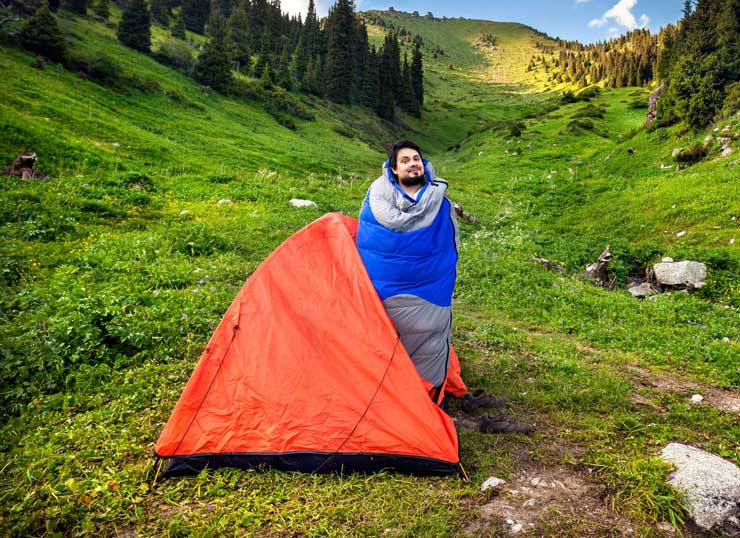 Today, we’ll look into what you need to know to choose a good air mattress. We’ll go over some basic rules-of-thumb and then we’ll mention a few specific products that might be right, depending on your scenario.
Today, we’ll look into what you need to know to choose a good air mattress. We’ll go over some basic rules-of-thumb and then we’ll mention a few specific products that might be right, depending on your scenario.
The basic questions
Before you even look at specific products, there are a few questions you need to ask yourself:
- Are you backpacking or driving to the trail?
- Will you be setting permanent camp or move daily?
- How do you adjust the size of the airbed to the size & shape of your tent?
Scenario 1: You’re driving to the trail & setting up camp to get back to each day
This is a scenario that will give you the most options to choose from because you don’t have to think about the weight of the airbed, the only thing to think about is fitting it into your tent.
The one mistake people make
You look at the space you have on the tent floor, you look at the dimensions of the air mattress, do the math and if they fit you might think that you’re OK.
It might sound basic, but we’ve seen it too often to ignore it – people tend not to take the slanted sides and the height of the air bed. This part is especially important if you have one of the two most common tent types – a ridge or a dome.
The inward sloping of the sides will become a problem if you go with a high-rise blow up mattress. The higher the air bed, the more it reduces the sleeping capacity of a tent with slanted walls.
For a 2-person tent
Rule of thumb: If it’s a 2-person tent you’re “working with”, a low-rise twin airbed or pad is your safest bet. Our picks as the best air mattresses for this scenario are the SoundAsleep Camping Series & the Lightspeed Outdoors TPU.
As per the user reviews we looked at, the SoundAsleep Camping Series is the top-rated classic airbed – it comes in Twin & Queen size, inflates in just under 3 minutes (the pump is included) and comes with a 1-year warranty.
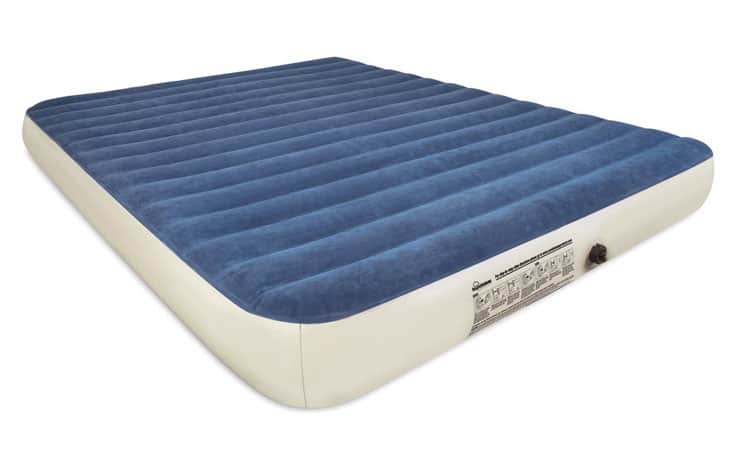
It sits at 9” and will not “waste” any significant tent space.
The Lightspeed Outdoors, on the other hand, is not what you’d call a classic model. The first thing that’s not classic about it is the material – it’s not vinyl but TPU. TPU is closer to the “feel” and characteristics of fabric than plastic.
It stretches less and, as a result, feels firmer.
The 2nd thing that’s worth mentioning is that it is an inch longer and an inch narrower than a twin airbed (usually 78 x 60 “). It sits at 8 inches high.
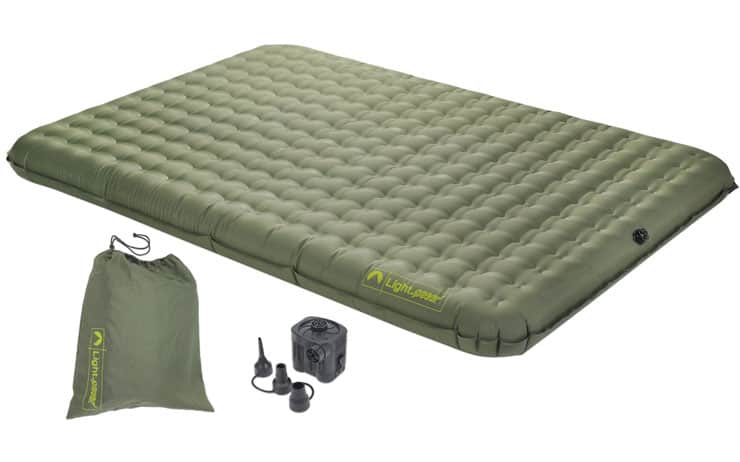
The SoundAsleep weighs just under 10 lbs (twin size) and the Lightspeed Outdoors is significantly lighter (just over 5 lbs).
Not only were these two models top-rated by users but they’re also labeled as best air mattress as per TheSleepStudies.com – a website that tests and reviews air beds.
For a 4-person tent
A 4-person tent will be approximately 65 feet square. These are large enough to comfortably fit in a queen size inflatable. Our pick here & the best queen size air mattress is the Coleman SupportRest.
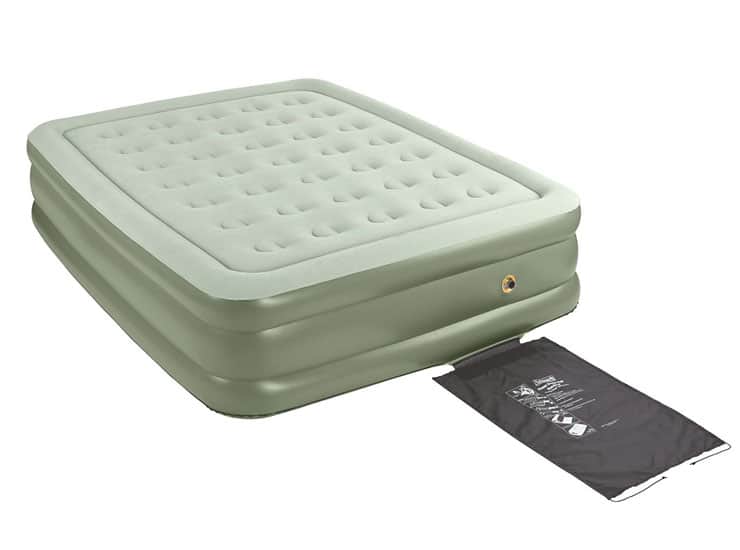
We didn’t have to do much research because this Coleman is the official camping air bed of the National Park Foundation.
It’s raised at about 20 inches and comes in Twin & Queen size. One thing to be aware of though, is that it doesn’t come with the pump by default. If you go with the Queen size, you’ll have to get the pump separately. The combined price of the two (the bed and the pump) is just over $70.
If you need something more durable & heavy-duty, you might look into Coleman DuraRest that was one of the top picks as per the Independent.co.uk.
Scenario 2: You’re backpacking or moving camp each day
In this scenario, an inflatable mattress will simply not be an option; they are too heavy to be carried around. You’ll want to go with a sleeping pad.
The best air camping air pads are significantly pricier than the options we mentioned above. The reason behind it is the fact that more technology goes into keeping you warm with a pad that’s lighter than 1 pound.
Our top pick here is the Therm-a-Rest NeoAir Xtherm. This Therm-a-Rest has been top-rated and listed as Editor’s choice as the best sleeping pad at OutDoorGearLab – a website that tests outdoor products, including sleeping pads.
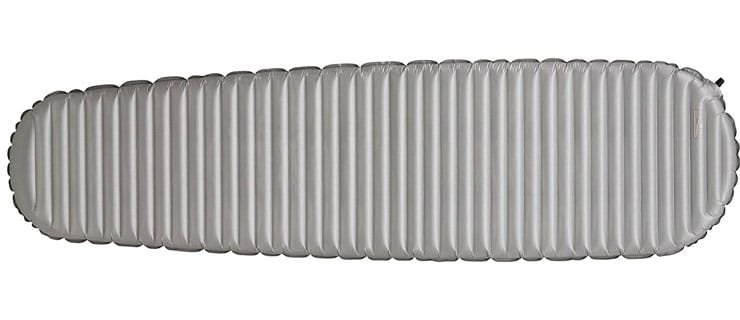
What’s better about it is that the company managed to design so that it’s amazingly light and thin (just over 1 pound and 2.5 “).
They did it by using what they call triangular core baffles and ThermaCapture material. The former minimizes heat transfer between the ground and top surface of the pad, while the later reflects the body warmth of the sleeper.
If you don’t need so much insulation
If you’re not expecting cold night on the trail, you can go with something more budget-friendly, like the Klymit Static V. It’s wider and more comfortable than most pads in its price range. You can see more reference info about types and option you have when choosing a sleeping pad on REI.com
Do bear in mind that the R-value (describes how well the pad insulates the sleeper) of this Klymit is much lower than the mentioned Therm-a-Rest NeoAir (1.5 vs. 5.7). This means that it will keep you comfortable but won’t do much in terms of keeping you warm.
We believe we got our bases covered
This guide was planned to look at the process of choosing from different angles and scenarios. We believe we’ve covered 90 % of those. If you have any questions, feel free to use the comment section and we’ll do our best to help.